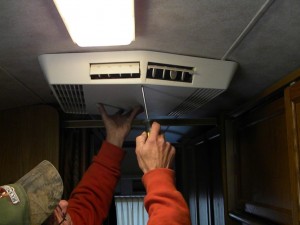The call of the wild spurs a lot of travelers to purchase an RV. Adventure is out there and just thinking about that perfect destination is enough to bring a smile on anyone’s face. But summer is right around the corner. The increasing heat outside spurs RVers to devise ways to keep cool. While a trip to the beach or the mountains are a great way to cool down, you still want to stay cool while driving and while parked.
This is what leads so many RVers to search out the best portable RV air conditioner they can find.
There are a lot of options out there. Here are some essential tips for choosing the very best portable RV air conditioner for your needs.
Before buying an air conditioner, it’s essential that you know the amount of BTU needed to cool your RV. This number is based on the square footage of the RV. A large RV needs over 18,000 BTU to assure a continuous cooling of the space. You really don’t want to buy an AC unit that is too weak and can’t sufficiently cool your RV. Here is a handy chart to help calculate your needs.

Here are four viable options to choose from.
1. Rooftop Air Conditioner
This is a popular choice. Because it resides on the roof of the RV, this air conditioner doesn’t take up extra space in the RV. Most rooftop air conditioners have between 5,000 and 15,000 BTU/Hour. This is a modest number considering that more than 30% of the energy is consumed through the vents. A single roof top air conditioner can cool an area 10 feet by 50 feet.

The unit is cooled by the outside air and is powered through your RV. Depending on the size of the unit it can use a ton of power, so this is not the best choice for those who are conserving energy or like to camp off the grid. Roof top air conditioners can also be costly to repair. Keeping the air conditioner on the roof exposes it the moist air, leading to rust and possible bacterial growth.
A roof top AC unit is also hard for the average person to install. Some weigh in at more than 100 lbs, so two people or more are needed to handle the installation. It also has a lot of wires and vents that needs to be connected properly. One shouldn’t do this if they lack proper qualification.
2. A Vent Free Portable Air Conditioner
This unit functions as a portable air conditioner, but is smaller in size and the design can be rather captivating. A vent-free air conditioner is also called a “swamp cooler” due to its unique moist air ventilation. No refrigeration process is used to cool the air. The air conditioner uses evaporated water that is released in the dry air, quickly chilling the room.

On the plus side it doesn’t consume very much energy since you only have to power the vent, and it doesn’t take up much space. On the negative side, you will need to improvise a hose since sometimes the water is not completely evaporated. This can cause water to leak through the device and all over the floor.
There is one small problem. The unit can only be used in climates with relatively dry heat. Humid weather will counter the cooling effect and nullify it. For a greater effect, the air conditioner’s evaporation process needs to blend with the dry atmosphere to form the chill effect.
3. The Portable RV Air Conditioner
This device uses one or two hoes to ventilate the hot air between the device and outside. It comes with adjustable frames that are placed under the window to keep the hoses in place. Be careful if you use the single hose air conditioner, since there is a strong possibility that hot air will come inside the room due to improper ventilation.

Portable RV air conditioners can be cheap, but they take up a ton of space. A lot of customers point out that these types of units are not very efficient and can sometimes be extremely costly. Also, the compressor of the conditioner is inside the room, so you will have to live with an annoying cooling sound for the rest of your road trip.
4. The RV Window Air Conditioner
Possibly the best choice in portable RV air conditioners. The window air conditioner offers great cooling capacity in a small package.

It doesn’t take up space (since it’s easily installed outside of the window), and it’s easy to maintain. If you search hard enough, you can find mini window air conditioners as small as 14 inches that open horizontally instead of vertically. Plus it houses all the necessary cooling components within one box (compressors, vents, etc) so noise pollution isn’t an problem.
Although all of the units have advantages and disadvantages, I would personally go for the window air conditioner.
What do you think? Add your input in the comments below.